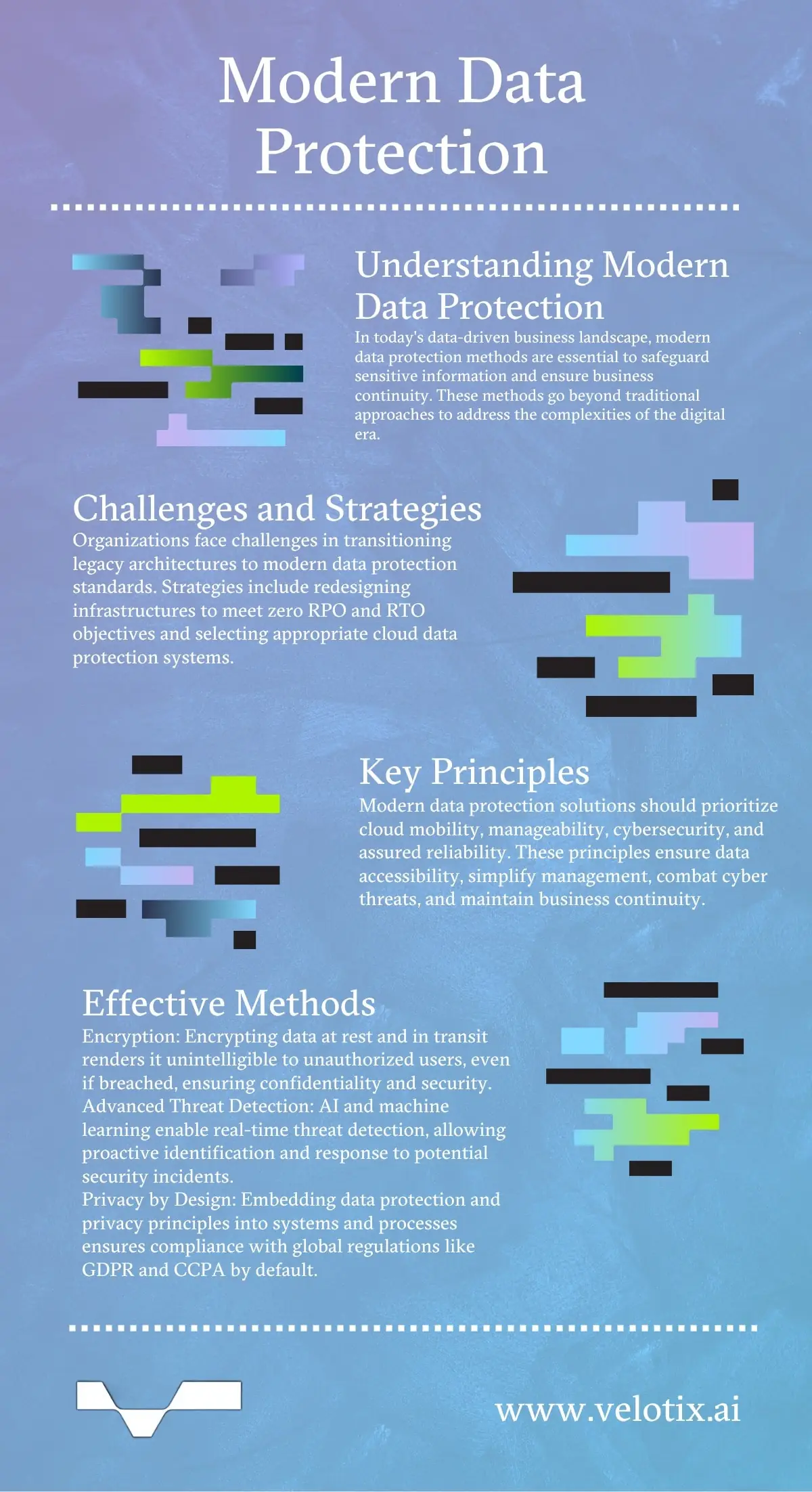As businesses become increasingly dependent on the data they collect, modern data protection methods become ever more critical. Where it was once enough to simply guard sensitive data, businesses must now adopt advanced data protection strategies with a broader range of capabilities that address the complexities of a modern digital landscape.
A significant challenge organizations face today is seamlessly transitioning legacy architectures into the modern era. How do they redesign existing data infrastructures to ensure zero RPO (Recovery Point Objective) and RTO (Recovery Time Objective)? Which cloud data protection system should they choose to guarantee adequate protection and recovery capabilities and meet their data security objectives?
Data Loss Protection in the Digital Era
Traditional data protection took a reactive approach, safeguarding systems in the event something happened. Modern data protection is a proactive method that uses advanced technologies, routine upgrades, and predictive analytics to prevent data storage system failure before it occurs. It replaces the practice of simple backups with mature remedies that:
- Empower businesses with secondary storage dataset usage, including tests, reports, and analytics.
- Ensure transparency across cloud platforms involving hybrid and multi-cloud solutions.
- Support easy, intelligent, and automated data retrieval so users can quickly complete their tasks.
- Simplify the implementation of AI-powered solutions.
To sum up, modern data protection is available and efficient. It ensures businesses can quickly recover from data loss incidents and leverage their data securely in real-time to protect against cyber threats and system failures.

Key Principles of Modern Data Protection
Today’s IT teams need modern data protection solutions that align with current cyber threats and leverage the cloud. Organizations are looking for data protection that provides:
- Cloud mobility. Businesses need to move data seamlessly across various cloud environments, enhancing flexibility and ensuring data accessibility. This capability ensures data isn’t tied to a single location, facilitating disaster recovery and global access.
- Manageability. Simplified management interfaces and automation of data protection tasks reduce the complexity and time required for data administration, enabling IT teams to focus on strategic tasks rather than routine maintenance.
- Cybersecurity. Advanced security features, including end-to-end encryption and anomaly detection, protect against data breaches and unauthorized access. It’s essential to continuously update these measures to combat evolving cyber threats.
- Assured reliability. Guaranteeing data integrity and availability, even during hardware failure or cyberattacks, is critical to maintaining business continuity. Typical techniques include regular testing and verification of backup and recovery processes.
Modern data protection strategies must be as dynamic and adaptable as the businesses they support, safekeeping of data and ensuring its utility and accessibility. Prioritizing cloud mobility, manageability, cybersecurity, and assured reliability safeguards your most valuable non-human asset against the threats and complexities of today’s digital landscape. Implementing these principles empowers your organization to navigate contemporary data security challenges confidently, turning potential vulnerabilities into strengths that drive growth and innovation.
Modern Data Protection Methods
There are numerous ways organizations can protect their data against modern threats. These four methods are particularly effective in establishing a solid protection framework.
1. Data Access Controls
Data access is often a tug-of-war between governance and security, with one wanting to ensure compliant data use and the other, typically data analysts and scientists, needing fast, efficient data access to do their jobs. Access controls aim to satisfy both sides.
Popular access controls include Attribute-Based Access Control (ABAC), Role-Based Access Control (RBAC), Discretionary Access Control (DAC), and Mandatory Access Control (MAC). Velotix uses an innovative and highly adaptable solution, Policy-Based Access Control, that allows businesses to quickly adjust access entitlement in response to requirement changes, ensuring assets are secure.
2. Encryption
Encrypting data at rest and in transit ensures that even if data is intercepted or accessed without authorization, it remains unintelligible and useless to attackers. This method is one of the most effective ways an organization can protect sensitive information from cyber threats, ensuring that the data remains secure and confidential, even if a breach occurs.
3. Advanced Threat Detection Technologies
Leveraging AI and machine learning for real-time threat detection allows companies to identify and respond to potential security incidents before they cause harm. Both technologies adapt and evolve based on new data, ensuring protection measures become smarter and more efficient over time.
4. Privacy by Design
By embedding data protection and privacy principles into the design, architecture, and operation of systems and processes, organizations can ensure privacy controls are baked into and seamlessly coordinated with systems and processes. A proactive, end-to-end solution, privacy by design facilitates global data protection regulation compliance regulations, including GDPR and CCPA, by default.
As cybersecurity threats become more frequent and sophisticated, many organizations have decided to invest in advanced cloud data protection platforms that enable them to stay ahead of emerging threats. AI-powered Velotix assists in automating policy enforcement in real-time, mapping internal and external data throughout its lifecycle, and speeding up data requests and approvals.